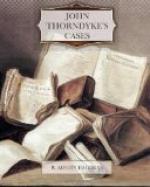He took off his coat, slipped on the gown, the mask, and the cap, and was, in a moment, in that dim light, transformed into the perfect semblance of a Chinaman.
“By taking a little more time,” he remarked, pointing to a pair of Chinese shoes and a large paper lantern, “the make-up could be rendered more complete; but this seems to have answered for our friend Alfred.”
“But,” said Mr. Brodribb, as Thorndyke shed the disguise, “still, I don’t understand—”
“I will make it clear to you in a moment,” said Thorndyke. He walked to the end of the closet, and, tapping the right-hand wall, said: “This is the back of the mirror. You see that it is hung on massive well-oiled hinges, and is supported on this large, rubber-tyred castor, which evidently has ball bearings. You observe three black cords running along the wall, and passing through those pulleys above. Now, when I pull this cord, notice what happens.”
He pulled one cord firmly, and immediately the mirror swung noiselessly inwards on its great castor, until it stood diagonally across the closet, where it was stopped by a rubber buffer.
“Bless my soul!” exclaimed Mr. Brodribb. “What an extraordinary thing!”
The effect was certainly very strange, for, the mirror being now exactly diagonal to the two closets they appeared to be a single, continuous passage, with a door at either end. On going up to the mirror, we found that the opening which it had occupied was filled by a sheet of plain glass, evidently placed there as a precaution to prevent any person from walking through from one closet into the other, and so discovering the trick.
“It’s all very puzzling,” said Mr. Brodribb; “I don’t clearly understand it now.”
“Let us finish here,” replied Thorndyke, “and then I will explain. Notice this black curtain. When I pull the second cord, it slides across the closet and cuts off the light. The mirror now reflects nothing into the other closet; it simply appears dark. And now I pull the third cord.”
He did so, and the mirror swung noiselessly back into its place.
“There is only one other thing to observe before we go out,” said Thorndyke, “and that is this other mirror standing with its face to the wall. This, of course, is the one that Fred Calverley originally saw at the end of the closet; it has since been removed, and the larger swinging glass put in its place. And now,” he continued, when we came out into the room, “let me explain the mechanism in detail. It was obvious to me, when I heard poor Fred Calverley’s story, that the mirror was ‘faked,’ and I drew a diagram of the probable arrangement, which turns out to be correct. Here it is.” He took a sheet of paper from his pocket and handed it to the lawyer. “There are two sketches. Sketch 1 shows the mirror in its ordinary position, closing the end of the closet. A person standing at A, of course, sees his reflection facing him at, apparently, A 1. Sketch 2 shows the mirror swung across. Now a person standing at A does not see his own reflection at all; but if some other person is standing in the other closet at B, A sees the reflection of B apparently at B 1—that is, in the identical position that his own reflection occupied when the mirror was straight across.”




